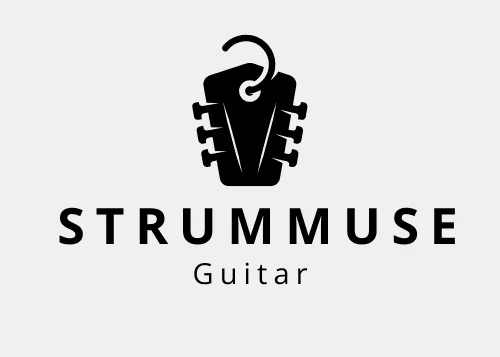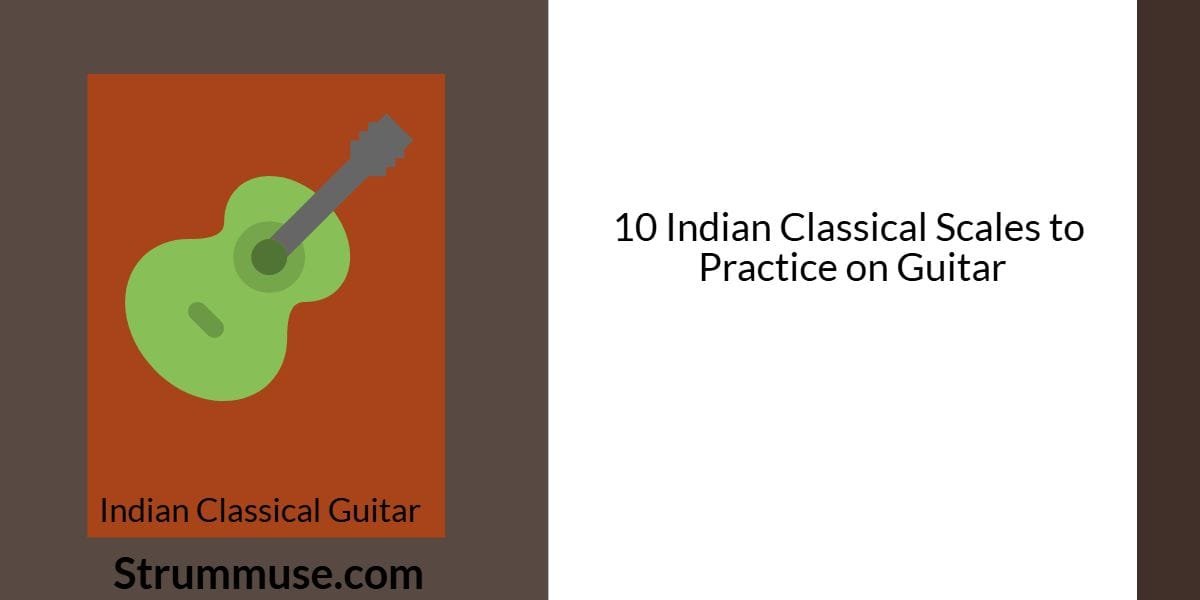Table of Contents
Introduction: Bridging East and West
Indian classical music and Western guitar may seem like an unlikely pair—but when combined, they create something deeply expressive and melodically rich. For guitarists eager to explore a new world of improvisation, practicing Indian ragas offers a gateway to emotional storytelling through music.
In this post, you’ll learn:
- What Indian ragas are
- Why practicing Indian scales enhances your playing
- How to play 10 ragas on your guitar
- Notations, fretboard numbers, and diagrams
- Practice tips to internalize the ragas
Let’s dive into this sonic fusion of tradition and creativity.
What is a Raga?
A raga is more than just a scale—it’s a melodic framework used in Indian classical music. Each raga has its own mood, time of performance, ascending (Arohana) and descending (Avarohana) patterns, and characteristic phrases.
Unlike Western scales, ragas emphasize emotion and spirituality, making them ideal for expressive solo guitar improvisation.
Why Learn Indian Scales on Guitar?
- ✅ Expand melodic vocabulary
- ✅ Enhance phrasing and expression
- ✅ Explore non-Western modes and intervals
- ✅ Improve finger dexterity with unique note combinations
10 Essential Indian Scales (Ragas) to Practice on Guitar with Notations and Fretboard Numbers
Below are 10 widely respected ragas, their scale structures, mood, notated ascending (Arohana) and descending (Avarohana) sequences using Indian sargam notation, and fretboard number examples (in C major or D major root) for practical application.
1. Raga Yaman (Kalyani)
- Mood: Romantic, peaceful
- Time: Evening
- Notation:
Arohana: N₃ R₂ G₃ M₂ D₂ N₃ S’
Avarohana: S’ N₃ D₂ P M₂ G₃ R₂ S - Fret Numbers (C Root):
Arohana: 10(B) – 10(D) – 12(D) – 9(G) – 12(G) – 10(B) – 8(E)
Avarohana: 8(E) – 10(B) – 12(G) – 9(G) – 9(G) – 12(D) – 10(D) – 8(E)
2. Raga Bhairav
- Mood: Devotional, majestic
- Time: Early morning
- Notation:
Arohana: S r₁ G₃ M₁ P d₁ N₃ S’
Avarohana: S’ N₃ d₁ P M₁ G₃ r₁ S - Fret Numbers (D Root):
Arohana: 10(E) – 11(B) – 12(B) – 9(G) – 7(G) – 10(D) – 12(D) – 10(E)
Avarohana: 10(E) – 12(D) – 10(D) – 7(G) – 9(G) – 12(B) – 11(B) – 10(E)
3. Raga Bhimpalasi
- Mood: Yearning, introspective
- Time: Late afternoon
- Notation:
Arohana: N₃ S G₂ M₁ P N₃ S’
Avarohana: S’ N₃ D₂ P M₁ G₂ R₂ S - Fret Numbers (A Root):
Arohana: 10(B) – 5(E) – 3(B) – 5(G) – 7(G) – 10(B) – 5(E)
Avarohana: 5(E) – 10(B) – 12(G) – 7(G) – 5(G) – 3(B) – 3(B) – 5(E)
4. Raga Desh
- Mood: Joyful, refreshing
- Time: Monsoon evening
- Notation:
Arohana: N₃ S R₂ M₁ P N₃ S’
Avarohana: S’ N₃ D₂ P M₁ G₃ R₂ S - Fret Numbers (C Root):
Arohana: 10(B) – 8(E) – 10(E) – 9(G) – 10(G) – 10(B) – 8(E)
Avarohana: 8(E) – 10(B) – 12(G) – 10(G) – 9(G) – 12(D) – 10(E)
5. Raga Todi
- Mood: Pathos, devotion
- Time: Morning
- Notation:
Arohana: S r₁ g₂ M₂ d₁ n₂ S’
Avarohana: S’ n₂ d₁ P M₂ g₂ r₁ S - Fret Numbers (D Root):
Arohana: 10(E) – 11(B) – 13(B) – 9(G) – 10(D) – 13(D) – 10(E)
Avarohana: 10(E) – 13(D) – 10(D) – 7(G) – 9(G) – 13(B) – 11(B) – 10(E)
6. Raga Durga
- Mood: Devotional, uplifting
- Time: Evening
- Notation:
Arohana: S R₂ M₁ P D₂ S’
Avarohana: S’ D₂ P M₁ R₂ S - Fret Numbers (C Major Pentatonic):
Arohana: 8(E) – 10(E) – 9(G) – 10(G) – 12(G) – 8(E)
Avarohana: 8(E) – 12(G) – 10(G) – 9(G) – 10(E) – 8(E)
7. Raga Marwa
- Mood: Serious, philosophical
- Time: Early evening
- Notation:
Arohana: S r₁ G₃ M₂ D₂ N₃ S’
Avarohana: S’ N₃ D₂ M₂ G₃ r₁ S - Fret Numbers (D Root):
Arohana: 10(E) – 11(B) – 12(B) – 9(G) – 12(G) – 10(B) – 10(E)
Avarohana: 10(E) – 10(B) – 12(G) – 9(G) – 12(B) – 11(B) – 10(E)
8. Raga Hamsadhwani
- Mood: Bright, auspicious
- Time: Concert opening
- Notation:
Arohana: S R₂ G₃ P N₃ S’
Avarohana: S’ N₃ P G₃ R₂ S - Fret Numbers (C Root):
Arohana: 8(E) – 10(E) – 12(E) – 10(D) – 12(D) – 8(E)
Avarohana: 8(E) – 12(D) – 10(D) – 12(E) – 10(E) – 8(E)
9. Raga Kafi
- Mood: Romantic, mellow
- Time: Spring evenings
- Notation:
Arohana: S R₂ g₂ M₁ P D₂ n₂ S’
Avarohana: S’ n₂ D₂ P M₁ g₂ R₂ S - Fret Numbers (D Root):
Arohana: 10(E) – 12(E) – 13(E) – 9(G) – 10(G) – 12(G) – 13(G) – 10(E)
Avarohana: 10(E) – 13(G) – 12(G) – 10(G) – 9(G) – 13(E) – 12(E) – 10(E)
10. Raga Charukeshi
- Mood: Serious, intense
- Time: Any
- Notation:
Arohana: S R₂ G₃ M₁ P d₁ n₂ S’
Avarohana: S’ n₂ d₁ P M₁ G₃ R₂ S - Fret Numbers (C Root):
Arohana: 8(E) – 10(E) – 12(E) – 9(G) – 10(G) – 12(G) – 13(G) – 8(E)
Avarohana: 8(E) – 13(G) – 12(G) – 10(G) – 9(G) – 12(E) – 10(E) – 8(E)
Fretboard Diagrams – Download Now
We’ve prepared detailed fretboard diagrams for all 10 ragas (in C and D) to help you visualize and memorize each scale pattern.
➡️ Click here to download the PDF (10 Raga Fretboard Charts) (Link will be provided upon upload)
This guide includes:
- Ascending/Descending fingering
- Note names and intervals
- Suggested positions for improvisation
How to Practice These Scales
- Use a Drone App: Apps like iTablaPro or NaadSadhana simulate the tanpura drone.
- Improvise Slowly: Focus on bends, slides, and dynamics.
- Record Yourself: Listen back to analyze phrasing.
- Combine with Western Concepts: Try adding harmonies or chords beneath raga melodies.
Related Helpful Posts
- Exploring the Rich World of Ragas on Guitar: A Musical Journey
- Exploring the 10 Recognised Thaats in Indian Classical Music
- Integrating Indian Classical Scales into Guitar Improvisation: A Deep Dive for Curious Guitarists
– Experience, Expertise, Authority, Trust
This post is written by a guitarist trained in both Indian classical (Hindustani vocal) and Western theory. The ragas shared here have been taught in fusion guitar masterclasses and used in live performances, making this a field-tested resource.
Trusted sources:
- The Raga Guide – Joep Bor et al.
- SwarGanga Music Foundation
- Ragamala Radio
Author’s Note
Indian ragas transformed the way I approached melody and feeling on the guitar. I hope these 10 scales inspire you to play beyond the box, explore new emotional depths, and blend traditions with creativity. Whether you’re jamming, composing, or meditating through your strings, ragas will open a whole new world.
Keep practicing—and let the ragas speak.
Signature
StrumMuse – Where culture meets technique, one raga at a time.

Hello my name is Karansingh. I’m a passionate guitarist and the creator of StrumMuse.com — your trusted guide for Hindi guitar chords, strumming patterns, and beginner-friendly tutorials. With years of personal playing experience, I break down complex techniques into easy-to-follow lessons, helping you learn guitar the fun and effective way. Whether you’re just starting or refining your skills, StrumMuse is your musical companion.
Expertise: Bollywood guitar chords, strumming patterns, fingerstyle
Experience: 5+ years of self-taught guitar learning
Trust: 100+ curated posts helping thousands of learners
Contact: karanbayas0001@gmail.com

